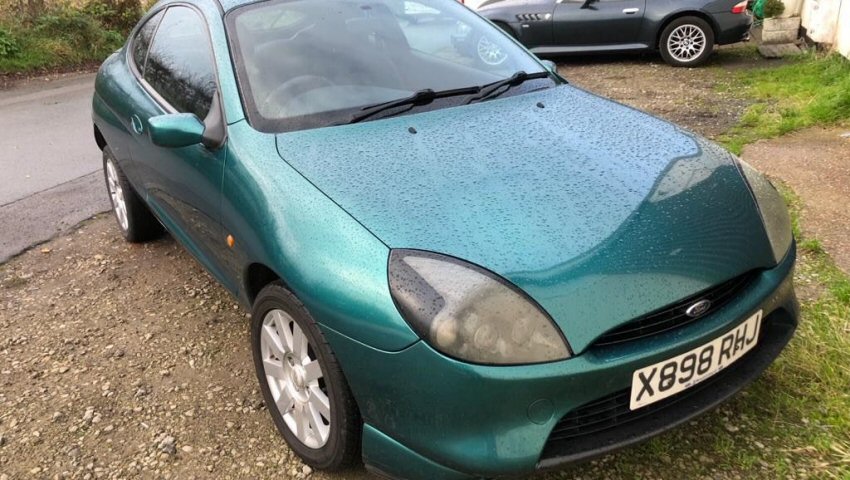
Cheap and Cheerful: The 2000 Ford Puma
Back in 1997, Ford decided to unveil a brand-new 2+2 coupe aimed at young people and petrolheads on a budget. Built exclusively at Fordís Niehl plant in Cologne, Germany, the Puma caught every motoring journalistís attention from day one.
Not only was it an affordable sporty coupe for the masses, but it was genuinely a fun little car. It was also the basis for a class R2 rally car which competed in the British Rally Championship, but we wonít get into that in this particular article.
The simple point of the matter is that if you want a cheap and cheerful sporty coupe, you canít beat the Puma. Take a look at this example Iíve managed to find on our website for instance. Itís a well-used car with 115,000 miles on the clock, but it looks like itís been looked after for most of its life.
Itís had five previous owners, which isnít too bad for a twenty-year-old car, and itíll set you back a measly £1,295. Seriously, what else can you think of for under £1,5k thatíll compete with the Puma? I can think of a few cars, but not many, and certainly none that will be in better nick than the little Ford.
Exterior
If youíre a fan of Fords built in the mid-to-late 1990s, youíll definitely love the look of the Puma. Letís start off with its dimensions because this is a really tiny car compared to some modern hatchbacks. At 3,984 mm long, itís a full three centimetres shorter than a brand-new used Ford Fiesta, which isnít a massive car in its own right.
The Puma has a square stance and low overhangs, something that becomes evident once you realize it has a 2,446 mm wheelbase, which is nearly as much as the Fiesta. I know it looks like a tiny car from the outside (and it is), but it makes good use of its interior space because of how extremely well-packaged it is, which weíll get to in a bit.
The real reason why the Puma looks so sporty and aggressive has to do with its width. At 1,837 mm wide, itís a good 10 centimetres wider than a 2020 Ford Fiesta, despite being lower and shorter.
Iím a big fan of the way the first-gen Puma looks too. Those headlights look amazing on such a small coupe body, and I love how unique the rear taillights are. Instead of using something from the Ford parts bin, they designed completely new units, bespoke to the Puma, making it feel a lot more special.
Interior
Inside, the Puma is relatively simple and minimalistic, but then again, which 20-year old car isnít? The simple fact is that everything works and functions as intended. If you can live without having modern tech features, it doesnít look terribly outdated as well. Yes, the plastics inside feel cheap and it isnít as good to look at as a modern car, but for a little over a thousand pounds, what more can you want?
For such a little car, the cabin feels surprisingly roomy, as I mentioned earlier. Because itís so wide (for a compact car), you have ample amounts of shoulder room, as well as headroom and legroom. The rear seats can feel cramped if youíre over ~180cm (5í10Ē), but theyíre definitely usable for shorter journeys.
It doesnít feel too dissimilar to a Peugeot 206 hatchback inside, but it obviously looks a lot sportier from the outside. The boot is easily big enough for a weekend getaway or the weekly shopping, so no complaints there.
Engine and Performance
The Ford Puma was available with three engine options: a 1.4, a 1.6, and a 1.7-litre Zetec-SE engine. This particular car is a 1.7 variant with 150 horsepower and 162 Nm of torque. I know that doesnít sound like a lot, but then again, the Puma hardly weighs anything either. At just over a tonne (1,035 kilograms), the Puma is a lightweight compared to most modern-day hatchbacks.
As such, itíll sprint to 62 mph in 7.9 seconds and go on to a top speed of 126 mph. I wouldnít call it necessarily fast, but it feels spritely. The engine loves to rev, and since it produces all of its power at the top, you get to take it up to redline each time you go out for a spirited drive.
The five-speed manual gearbox feels great too. The throw is quite long but relatively precise and the pedals are decently positioned for heel-and-toe. Since the Puma has a hydraulic steering wheel, it feels miles better than most modern hatchbacks in terms of feedback. Obviously, itís a lot looser than most modern steering units, but itís lovely to feel the steering wheel wriggle in your hands and communicate what the car is doing underneath you.
Since it doesnít weight much, the Puma is extremely nimble and agile, especially at low-to-medium speeds. It was built to terrorize city streets and dominate car parks. The engine feels particularly punch in the first two gears too, perfectly complimenting the lovely chassis.
The aftermarket community is huge with these cars, so if youíre thinking of buying one as a project car that youíll take to the track, I say go for it.
Model: Ford Puma
Year: 2000
Trim: 1.7 3dr
Mileage: 115,000
Price: £1,295
Conclusion
If you have less than £2k to spend on a small, sporty 2+2 coupe, you have to drive a Puma. I realize not everyone is a fan of the way it looks, but if you go out and drive one, youíll see what I mean for yourself. Itís a riot to drive, especially if you love to be a bit of a hooligan from time to time. Find a perfect example by checking out the used Ford Puma cars for sale on DesperateSeller.co.uk.
DesperateSeller.co.uk rating: 8 out of 10













